The Apple iPad Air 2 Review
by Joshua Ho on November 7, 2014 9:30 AM EST- Posted in
- Tablets
- Apple
- Mobile
- iOS
- ipad Air 2
CPU Performance
Now that we’ve managed to take a good look at the changes between the A8 and A8X, we can get a good idea of what those differences translate to in some real world performance. While we’ve already seen pure CPU performance, such differences can be small when viewed from real applications. To this end, we use a few browser benchmarks and similar benchmarks. I definitely want to caution against comparing SoCs across platforms though, as rendering engines have a significant effect upon the performance of the device.


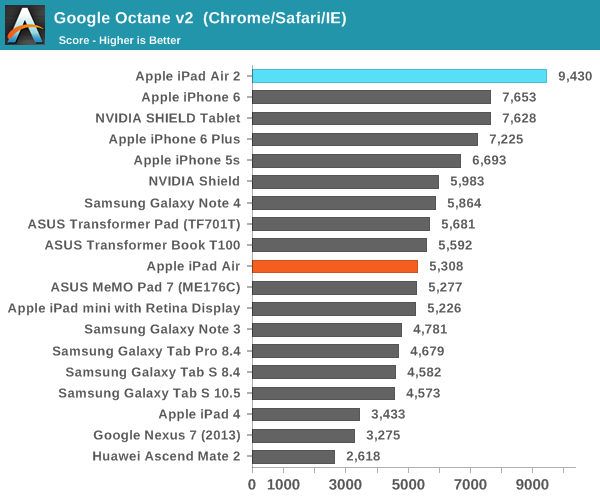
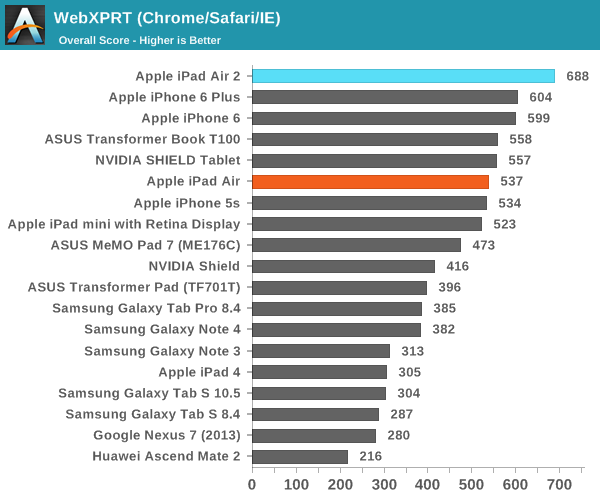

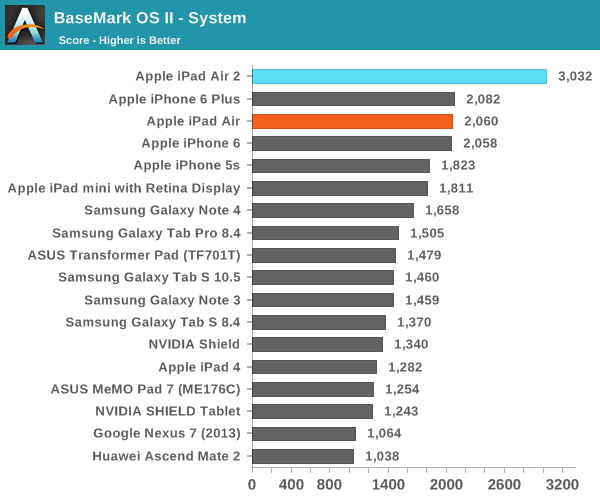
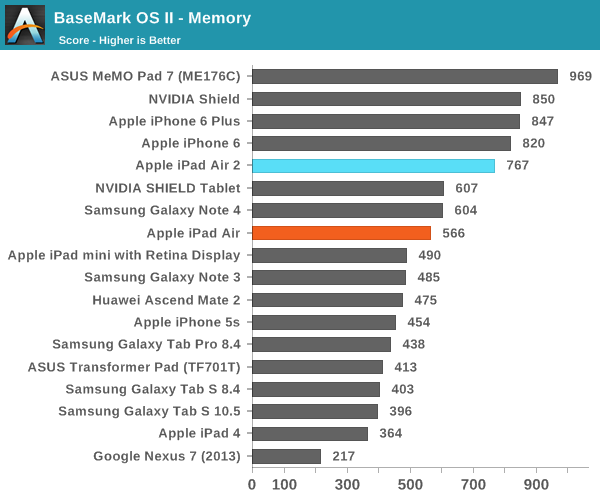
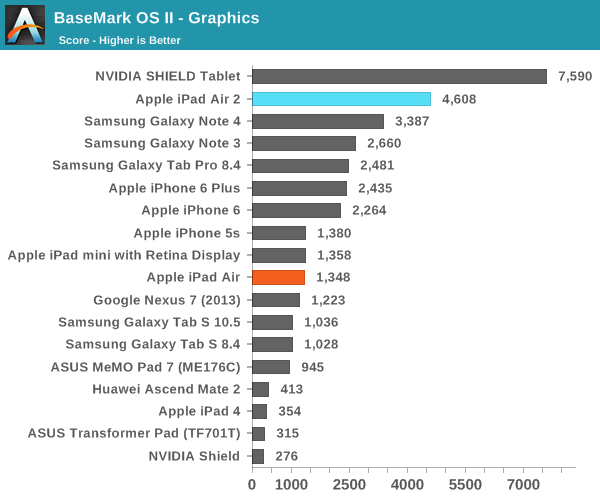
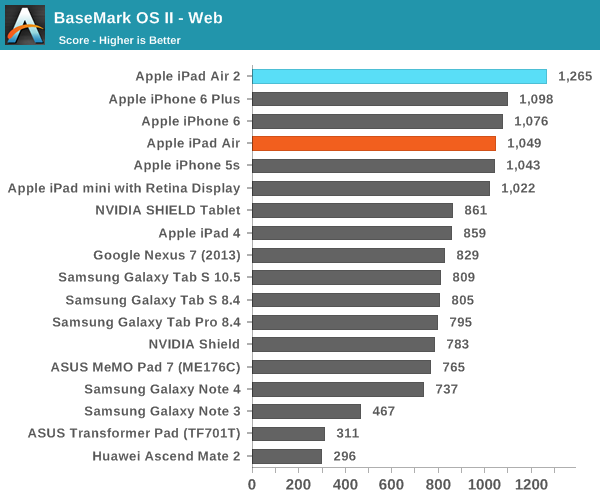
There's really not too much that needs to be said here, as the extra core and minor clock speed bump make for ridiculous amounts of performance. The A8X is class-leading here despite generally having fewer cores and lower clocks than the rest of the competition. However, in comparison to A8 we don't see a massive jump in performance. This seems to suggest that even a third core will invoke diminishing returns in general, although these changes mean that it's enough for the iPad Air 2 to be one of the fastest ARM-based devices on the market. One can see an odd regression in the Basemark OS II storage test, but this is likely to be production variances in NAND quality rather than anything notable.










226 Comments
View All Comments
Sushisamurai - Friday, November 7, 2014 - link
You should mention in the design segment, that there is a consequence with the thinness. I was playing some media (TV show, the 100, gotham), and due to the thinness, with the volume turned up, the iPad would reverberate/vibrate due to the audio output.In my opinion, the loss of a few millimetres was not worth this trade off, as my iPad 2 never shook when playing music or movies from its speakers at full blast.
chaosbloodterfly - Friday, November 7, 2014 - link
My old HP touchpad used to do that, but the sound quality was really good (and loud) for a tablet (like comparable to your average bluetooth speaker box things).Sushisamurai - Friday, November 7, 2014 - link
I noticed you added it in the misc section. It is still a design consideration IMO. Tomato tomato. It's my only gripe with the iPad Air 2. That and maybe ios8 - it's still a little buggy for me.KPOM - Friday, November 7, 2014 - link
Another thorough review by AT. I think software should be the next major focus for Apple with the iPad. The CPU and GPU power are getting to the point where the iPad could replace a laptop, provided the software were there. Maybe we'll see true multitasking and split window displays if and when the iPad Pro comes out with a 12+" screen. That third CPU core must be there for more than just games.steven75 - Friday, November 7, 2014 - link
I think they are heading this way.-iPad Pro rumors
-IBM deal
-MS Office (iWork since 2011, but still)
-iCloud Drive and support for third party cloud storage in the native file picker.
And now beefed up hardware that makes more sense for laptop-type usage.
esterhasz - Friday, November 7, 2014 - link
Good points and you're probably right.But I still think that multitasking is great on a desktop/laptop not so much because of the windows, but because of the control scheme: using the dominant hand for the pointer (like on touch) and the other for focus switching (like between programs) is just so insanely efficient. Bringing in the second hand for doing something simply does not work that fluidly on a touch device. And that would ultimately hamper the direction you're describing.
Or I may simply suck at touching.
ABR - Friday, November 7, 2014 - link
It's amusing to me when people talk about needing to multitask on tablets. 90% of the people I see using 24" desktops zoom every window they use to full-screen. It's actually HARDER to read the long lines of text or mouse around large expanses of blank space this way, but people like to focus on one thing at a time I guess. I tend to be more of the "use virtual space to organize the workflow" type when I've got that kind of real estate, but I rarely have the desire to do more than switch between fullscreen apps on a tablet.Still, we may see Apple add some kind of split-screen mode if only because people think they want it, like they gave us the comically unwieldy iPhone 6+.
Crackhour - Saturday, November 8, 2014 - link
I have the samsung 10.1 2014 edition and I never split screen. I like to focus on one screen so it seems. Apple seem to know this is reason it hasn't adopted the split screen my opinion. It just negates you the choiceStealthX32 - Friday, November 7, 2014 - link
Uhm, what planet do you live on where Apple cares about anything but the consumer market? Hmm, instead of giving developers incentives to write on OSX/iOS, let's give U2 $100 million dollars instead. Yeah, that's what will advance them as a company.ams23 - Friday, November 7, 2014 - link
Josh, don't you think it is a bit misleading to show a chart with a long-term fps of 46fps for Shield tablet in the GFXBench T-Rex Onscreen test when it was able to maintain an fps of ~ 55fps for the first 100 (!) continuously looped runs of the test (which represents nearly two hours of continuous use!)? I don't see how the 46fps is a realistic number for comparison. Even the GFXBench website lists a long-term median performance result of ~ 55fps for Shield tablet.Also note that Tegra K1 has higher render quality in GFXBench than A8X and any other ultra mobile SoC, so it is doing more work in that test.
A8X is a fantastic SoC and iPad Air 2 is an awesome tablet, but do note that iPad Air 2 has some significant performance-reducing throttling in both Geekbench 3 and 3dmark Ice Storm Unlimited. With long-term testing, the performance of A8X drops by ~ 30% in Geekbench 3 and drops by ~ 15% in 3dmark Ice Storm Unlimited: http://www.notebookcheck.net/Apple-iPad-Air-2-A156...
(It is my understanding that Shield tablet has virtually no CPU/GPU throttling due to use of the internal magnesium plate to dissipate heat).
On a side note, here is what OlegSH had to say about the GFXBench 3.0 T-Rex Onscreen test: "It's strange to see GLBenchmark 2.7 test as battery life test in GFXBench 3.0
Kishonti uses low precision FP16 shaders for T-Rex by default, that has quite noticeable impact on picture quality, just look at MP(medium precision) PSNR, hence the perfect MP PSNR for K1, looks like K1 doesn't support FP16. This combined with small amount of geometry, very simple shaders, lots of blending make this test perfect fit for tiled architectures. I don't believe lifetime results will stay the same once they move to Manhattan as power test".